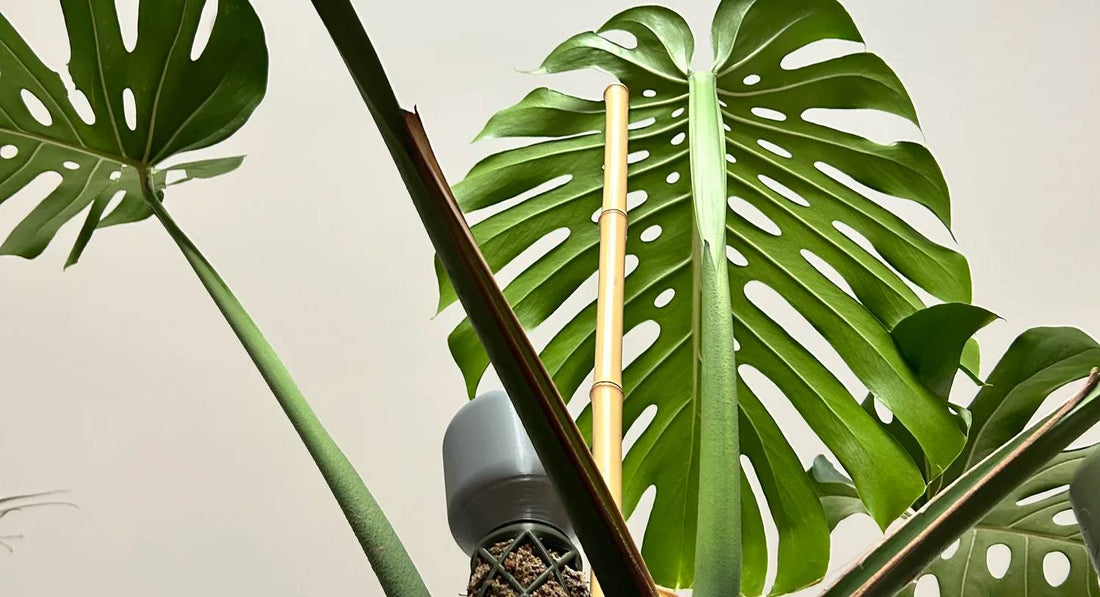
Monstera guide - different Monstera types
Share
Monsteras are having a moment, and we can see why!
Monsteras are popular tropical indoor plants known for their distinctive foliage and easy-care nature. They are also fun to collect, and Monsteras look good whether they are small baby plants, or larger, mature ones. We love their versatility and have quite a few at home.
There are several types of Monstera, and each has its own unique characteristics (all of them pairing well with our moss poles).
Here's a quick guide to some common Monstera types!
Monstera deliciosa: popular, versatile Swiss Cheese best-seller

Also known as the Swiss cheese plant, this is the most common Monstera you see in pretty much all plant shops (and for good reason). It has large, glossy, split leaves with holes that give it a unique appearance, plus it’s a plant that looks good when it’s both small and more mature. It fenestrates more as it grows: sometimes the small ones you buy start with minimal perforation.
We love this affordable and beginner-friendly plant that looks good as it grows. Once it matures, it gets quite heavy, so be prepared to propagate and use moss poles and stakes to support the stem and leaves.

Care Tips:
Requires bright, indirect light, well-draining soil, and regular watering. Allow the top inch of soil to dry out between waterings.
Monstera adansonii: beautiful perforated leaves

Also called the Swiss cheese vine, this Monstera has smaller and more perforated leaves than Monstera deliciosa. The leaves are typically more delicate and elongated. This plant is a crowd-pleaser, and one that people tend to fall in love with. The Adansonii pictured has had its own journey - see it here when we first potted it up. Another affordable plant that brings great results.
Rarer more expensive Adansonii variegations include the Monstera Adansonii Mint and Albo.
Care Tips:
Similar care requirements to Monstera deliciosa, but the Adansonii may appreciate a bit more humidity. Ideal for hanging baskets or moss poles, especially the XL line or D-shaped ones.
Monstera obliqua/Monstera obliqua Peru

The plant pictured is the Monstera obliqua Peru.
Often confused with Monstera adansonii, but it has more holes and perforations in its leaves. It is rare and highly sought after by collectors: we love our Peru! It is a very dramatic looking Monstera.
Care Tips:
Similar care to other Monstera types, but it can be more challenging to find and may be more demanding in terms of humidity and warmth.
Monstera siltepecana: velvet leaf beauty
Known for its silvery-green leaves with dark green veins. The leaves are elongated and have a velvety texture. We love our Siltepecana, here on our D- moss pole.
Care Tips:
Similar to Monstera adansonii but may require slightly more attention to humidity levels.
Monstera karstenianum (Monstera Peru): small emerald beauty
Recognised by its smaller, heart-shaped leaves with a glossy texture. The leaves have a leathery texture and may have a reddish tint on the undersides. This is a very intricate and elegant Monstera.
Care Tips
Prefers bright, indirect light and well-draining soil. Keep the soil consistently moist but not waterlogged.
Monstera dubia: moss pole and trellis queen

Dubias can get really big, and they have beautiful leaves that start off delicate and then mature into these beautiful, intricate patterns with darker and lighter spots.

Dubias love to vine and are perfect for moss poles, trellises, or planks. The bigger they get and the higher they climb, the bigger the leaves get. Rigid Dubia stems mean that you have to train this plant as it grows.
Care Tips:
Likes indirect light, prerefably bright. Water only when dry and water thoroughly.
Monstera epipremnoides (Esqueleto)

Similar to Monstera adansonii, but with more pronounced holes and unique leaf shapes. It is less common and more challenging to find, but we love this dramatic and unique Monstera!

Care Tips:
Requires warm temperatures, high humidity, and well-draining soil.
Monstera pinnatipartita
Features deeply lobed leaves with multiple cuts, giving it an intricate appearance.
Care Tips:
Similar care to Monstera deliciosa, with well-draining soil and bright, indirect light.
Variegation in Monsteras
Monsteras variegate beautifully, just like Philodendrons. (Variegation explained here).
Monstera types will produce Albo varieties (white or partly-white) leaves, and the Monstera Thai constellation is a variegated Monstera that is highly sough-after, with a price tag to match.

Our Thai constellation pictured.
General Monstera care advice
- Light: Most Monstera varieties prefer bright, indirect light. Avoid direct sunlight, as it can scorch the leaves.
- Watering: Allow the top inch of soil to dry out before watering. Overwatering can lead to root rot, so be careful with that. Monsteras do however like to be thoroughly watered, so moss poles can help you with consistent hydration. Moss pole hydration tips here.
- Humidity: While they can adapt to average humidity, higher humidity levels are beneficial, especially for certain varieties.
- Soil: Use a well-draining potting mix to prevent waterlogged roots. We sell an indoor plant soil mix that is calibrated for Monsteras.
- Support: Provide support for climbing varieties by using moss poles, stakes or trellises.





